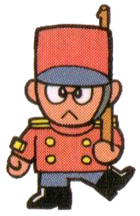Kiddokatto
The title of this article is official, but it comes from a non-English source. If an acceptable English source is found, then the article should be moved to its appropriate title.
| Kiddokatto | |
|---|---|

| |
| First appearance | Super Mario Land 2: 6 Golden Coins (1992) |
Kiddokatto are regular enemies Mario encounters in the Mario Zone's third stage in Super Mario Land 2: 6 Golden Coins. They are toy soldiers wearing miniature bearskin caps that march forward, usually appearing one after the other. While they move at a moderate pace, they have no other attacks and one jump on the head or a fireball will finish it off.
Profiles and statistics
Perfect Ban Mario Character Daijiten
キッドカット
種族 メカ族
性格 単純
登場ゲーム ランド2
1・2を争うやられキャラ
トコトコ歩いてくる、ブリキのおもちゃの兵隊さん。マリオキャラクターの中でもトップクラスの単純な動きで、簡単に踏みつぶすことができ、ちょっとかわいそうなくらい。[1]
Kiddokatto
Tribe: Mecha clan
Disposition: Simple
Game appearances: Land 2
One or two of the most beaten down characters
A tin toy soldier that toddles along. With one of the simplest movements of any Mario character, he can easily be stepped on and squashed, which is a bit pitiful.
Encyclopedia Super Mario Bros.
Bio: まっすぐ歩いてくるだけのブリキの兵隊。 (Tin soldiers who just walk straight at you.)[2]
Gallery
Names in other languages
| Language | Name | Meaning |
|---|---|---|
| Japanese | キッドカット[3][1] Kiddo Katto |
Kid Cut |
| German | Kidcut |
|
| Italian | Kiddokatto[4] |
- |
References
- ^ a b Shogakukan. 1994.「パーフェクト版 マリオキャラクター大事典」 (Perfect Ban Mario Character Daijiten), page 59.
- ^ Shogakukan. 2015. Super Mario Bros. Hyakka: Nintendo Kōshiki Guidebook, Super Mario Land 2 section, page 75.
- ^ 「任天堂公式ガイドブック スーパーマリオランド2 6つの金貨」 (Nintendo Kōshiki Guidebook – Super Mario Land 2: 6 Golden Coins), page 15.
- ^ Super Mario Bros. Enciclopedia; pag. 75
